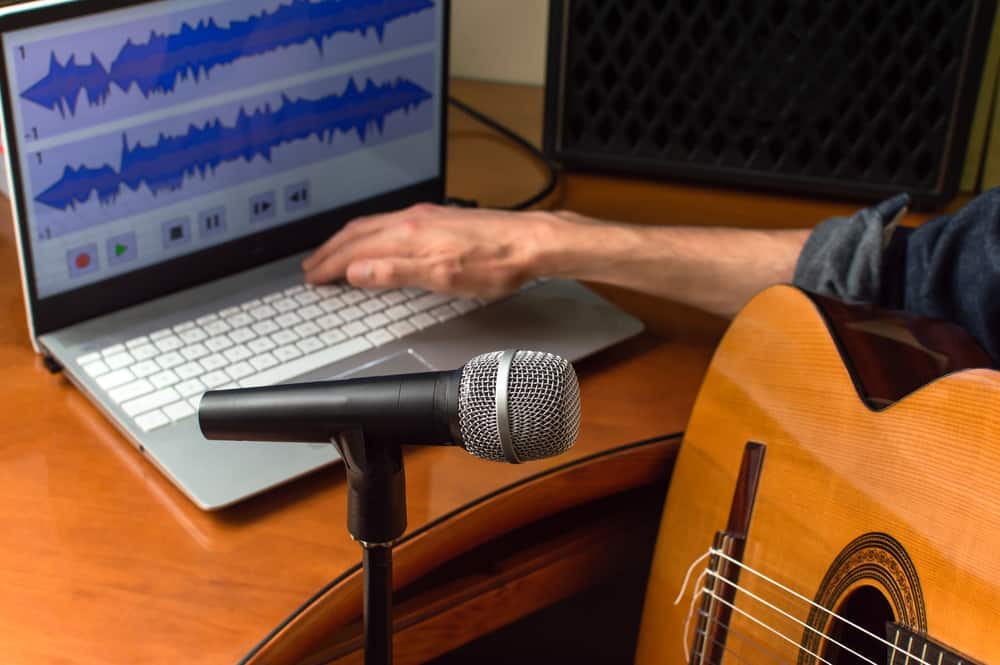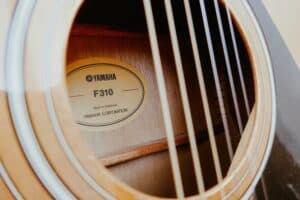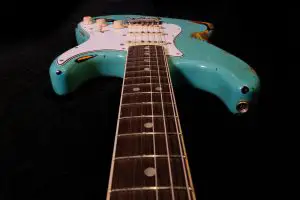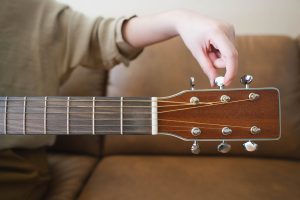
There comes a stage in your guitar-playing career where you’ll feel the urge to record yourself. It might be when you start writing your songs and want to hear how they sound or when you want your friends to hear the beautiful cover you recorded. Some even record themselves as a form of self-analysis and a way to improve their play.
Whichever it is, setting up a basic guitar recording setup in your home is something you’ll fully enjoy. Luckily, technology has made home recording very easy, and there are now many ways you can record your guitar on a PC.
So how do you connect and record your guitar on a PC?
To record an acoustic guitar on your PC, you’ll need a mic to capture your guitar’s sound and an audio interface to capture the mic’s recording and transfer it to the PC using audio cables. For electric guitars, all you need is an audio interface, a guitar lead, and music recording software.
However, there’s more to guitar recording on PC than the summary above. Here, we’ll go down to the details and give you step-by-step methods on the different ways you can connect and record your guitar on a PC.
How To Record an Acoustic Guitar on PC

Here are some of the best ways to use your PC to record an acoustic guitar.
Method #1: Record With a Large-Diaphragm Condenser Microphone and an Audio Interface
What do you need to record acoustic guitar with a large-diaphragm condenser microphone:
- A decent large-diaphragm condenser microphone and a microphone stand
- An audio interface that supports phantom power and XLR microphone input
- Audio cables – XLR lead
- An acoustic guitar
Large-diaphragm condenser microphones are the best for recording acoustic guitars because, if positioned properly, they can make the guitar sound bigger, clearer, and more engaging.
However, the sound you’ll hear after recording will largely depend on the location of the mic. Different locations will pick up different facets of the guitar sound. You must experiment and figure out the location that fully aligns with your playing taste.
To begin, place the large-diaphragm condenser mic about 3 feet away from the guitar’s sound hole. It should also be slightly positioned towards the neck so you’ll capture the string’s vibration.
Lastly, your room might need a proper acoustic treatment if you notice your recordings are a bit erratic or muddy even after changing mic positions.
Method #2: Record Directly From Guitar’s Output to Audio Interface’s Instrument Input
What do you need to record acoustic guitar directly from the guitar’s output:
- An audio interface that supports instrument input
- Audio cables – Guitar lead
- A recording software
- An electro-acoustic guitar with a 1/4″ output
This Is one of the numerous perks of electro-acoustic guitars; you don’t need a mic to record on a PC.
Connect your guitar’s output to the input of your audio interface using a guitar lead. The audio interface will send your sounds to the PC, where you can capture and edit them with recording software.
The major disadvantage of this method is the lack of purity and richness of the recording. Many guitarists have complained of bland sounds and major differences from the guitar’s actual sound. Plus, the string’s vibrations are not captured in the recording.
But even with all this, the method is loved because of the ease of setup. You don’t need to start positioning your mic before recording; just plug your guitar into an audio interface and record away. Lastly, your room doesn’t need acoustic treatment since the recording is direct.
How To Record an Electric Guitar on PC

Here are some of the best ways to use your PC to record an electric guitar.
Method #1: Record Your Guitar Directly Using Guitar-USB Interface
What do you need to record electric guitar directly using the USB:
- An electric guitar
- A guitar-USB interface
- A recording software
This is probably the fastest and easiest way to record an electric guitar on your PC. You can plug your guitar into a standard guitar-USB interface with an audio cable and connect it to a PC with a USB cable.
The interface will capture the guitar’s raw and dry sounds, but with quality recording software installed on your PC, you should be able to tweak it to your liking.
Method #2: Record Directly From Your Guitar Into Instrument Input on Audio Interface
What do you need to record directly from your guitar into instrument input:
- An audio interface
- Audio cables – Guitar lead
- A good recording software
- An electric or bass guitar
Firstly, connect your audio interface to your PC. After this, connect your guitar’s output to the interface’s input and start recording.
This method will definitely not bring the best out of your guitar, and you might need to back it up with many plugins and amp simulators.
With the guitar-interface-PC direct method, you store your raw recordings for as long as you please and tweak them to fit your style.
Method #3: Connect Your Guitar to an Audio Interface Using Amp
What do you need to record your electric guitar using an amp:
- An audio interface
- An amp
- Audio cables – Guitar lead and cable to connect the amp to the interface
- A good recording software
- An electric guitar
If you’ve grown accustomed to the sound of your amp and want it to be a part of your recording, this method is for you.
Though you can just position a mic on a speaker and record, this method is less stressful; all you need are some simple connections, and you can start recording.
To begin, connect your guitar’s output to your amp’s input like you normally do. Then connect the amp’s output to the input on the audio interface. From there, you can connect the audio interface to your PC and use recording software to capture your sound.
This method is a bit complex as you’ll have to tweak your guitar, amp, and audio interface to get your preferred sound.
The Bottom Line
Many guitarists, especially beginners, really want to record themselves and know how they sound. But there’s this general belief that setting up a basic guitar recording setup is a very complex process. This is untrue.
For acoustic guitars, all you need is a mic to capture the sound from the sound hole. The mic will be plugged into an audio interface already connected to your PC. If it’s an electro-acoustic guitar, you can just connect it directly to the audio interface without a mic.
Electric guitars also involve the use of an audio interface that’s connected to both the guitar and PC. If you want to record with your amp, you can plug your guitar into the amp and connect the amp to an audio interface.
With all these tips, you should be able to start recording your original songs or covers of songs you can seem to get out of your head.









